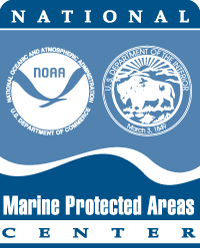Intellectual Property and Sensitive Information
A Resource by the Marine Protected Areas Federal Advisory Committee (These statements do not necessarily reflect the positions of NOAA or the U.S. Government)

MPA managers are responsible for the protection of sensitive information and intellectual property. Disclosure of information such as site location, ownership data, and site characteristics has the potential to jeopardize cultural resources. Legal mechanisms such as the Archaeological Resources Protection Act (ARPA), the National Historic Preservation Act (NHPA), and the Freedom of Information Act (FOIA) provide protections for sensitive information.
Intellectual Property (IP) refers to creations of the human mind and IP rights protect the rights of creators over their creations. IP is generally understood within the framework of the Western legal system and concepts of individual property. Legal mechanisms are available to protect IP such as copyrights, trademarks, patents, and trade secrets. However, these mechanisms are often insufficient for protecting collective or community-based IP which is created and maintained through a transgenerational process of information exchange and "owned" by the community rather than by individuals. This type of IP is prevalent within the realm of cultural resources management. Some examples include art, language, symbols, music, oral narratives, and traditional knowledge.
Responsible cultural resources management requires a comprehensive understanding of where IP rights and sensitive information may be at risk and the mechanisms available for protecting both tangible and intangible forms of information, knowledge, and cultural expressions.
Opportunities and Obligations

An awareness of IP and sensitive information reinforces a sound conservation ethic and supports compliance with federal mandates, customary laws, and international conventions. MPA managers face tensions between their public education requirements and issues of confidentiality, resource or stakeholder protection, and tribal rights protection. Inappropriate use or release of information and knowledge can inflict harm on both resources and people. For example, disclosure of site location may lead to vandalism, and release of information on traditional practices may jeopardize a community's ability to conduct such practices, or result in exploitation of tribal culture. International conventions exist to protect indigenous peoples and traditional knowledges from exploitation.
By virtue of their role as stewards of our cultural and natural resources, MPA managers must be diligent in the area of information management. In recent years, cultural heritage management has evolved to encompass relationships between cultural landscapes and related information, knowledge and cultural expressions, resulting in expanded protection of information beyond simple sight locations. Much of this work is grounded in evolving concepts of IP and sensitive information management. Successful resource management requires support from various stakeholders such as tribal communities, fishers, divers, academics, landowners, etc. Poor or careless information management can jeopardize relationships between MPA managers and stakeholders. Strategies that acknowledge the IP rights and contributions of stakeholders foster good relations and enrich MPAs by way of enhanced data, improved management techniques, and shared stewardship.
Methods and Approaches

Sound IP and sensitive information protection and management strategies are multi-faceted and should blend legal and non-legal approaches. An effective strategy for addressing IP and sensitive information issues is a management plan that incorporates mechanisms for preventing IP rights violations and provides procedures to protect sensitive information against compromise. An ongoing tribal consultation and community engagement agenda is essential to this approach. Through this process, management can support equitable terms of research, guidance, and policies that address both tangible and intangible cultural heritage. Protocols and agreements can be useful tools in defining how information and knowledge is used, controlled and accessed, to the benefit of all stakeholders.
Management should also have a firm understanding of legal mechanisms available for protecting and managing IP and sensitive information. Legal tools such as copyrights, trademarks, and patents can serve to protect IP. However, these laws have limited applicability for community-based or collectively-owned knowledges. Additionally, federal laws such as ARPA, NHPA and FOIA are useful tools for protecting sensitive information in the federal arena. Each offers specific protections for categories of cultural resources-related information such as site location or ownership data.
Resources
Indigenous Peoples and Intellectual Property (Graham and McJohn, Washington University Journal of Law and Policy, January 2005).
Seeking consent for research with indigenous communities: a systematic review, BMC Med Ethics. 2016; 17: 65.
(See also resources under Outreach)
 Marine Protected Areas
Marine Protected Areas